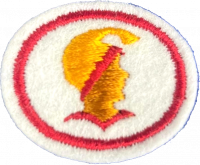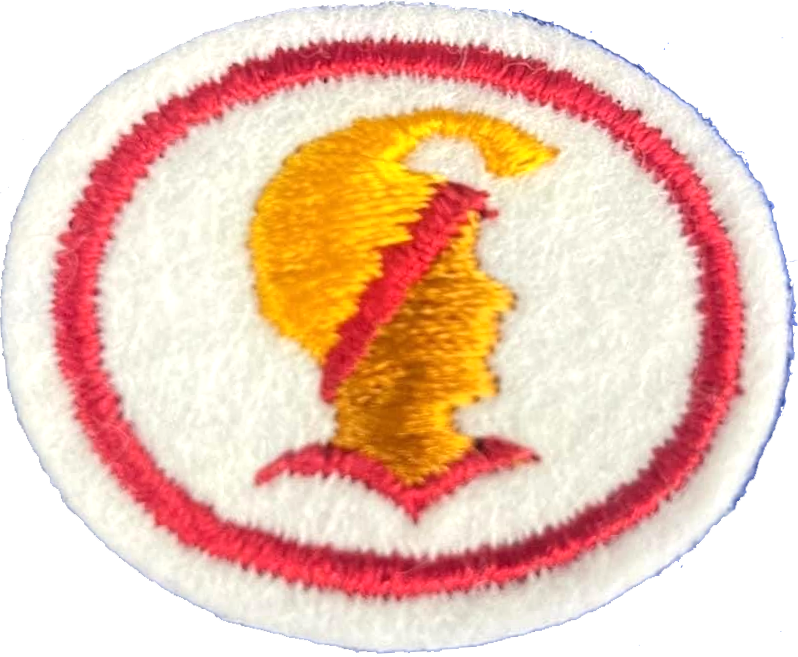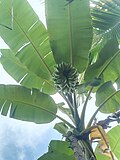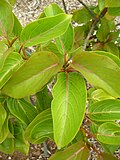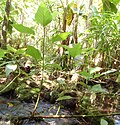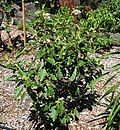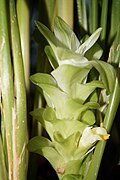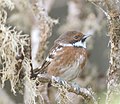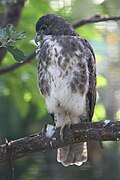Difference between revisions of "AY Honors/Hawaiian Lore/Answer Key"
(+ some more answers) |
(Marked this version for translation) |
||
| (5 intermediate revisions by the same user not shown) | |||
| Line 8: | Line 8: | ||
<!-- 1. Name the eight inhabited Hawaiian islands according to size. --> | <!-- 1. Name the eight inhabited Hawaiian islands according to size. --> | ||
| + | <!--T:91--> | ||
Here is a [[w:List_of_islands_of_Hawaii|list of the islands of Hawaii]]. | Here is a [[w:List_of_islands_of_Hawaii|list of the islands of Hawaii]]. | ||
| + | <!--T:92--> | ||
{| border="1" cellspacing="0" cellpadding="4" | {| border="1" cellspacing="0" cellpadding="4" | ||
|- | |- | ||
| Line 34: | Line 36: | ||
<!-- 2. Name the four uninhabited islands. --> | <!-- 2. Name the four uninhabited islands. --> | ||
| + | <!--T:93--> | ||
{| border="1" cellspacing="0" cellpadding="4" | {| border="1" cellspacing="0" cellpadding="4" | ||
|- | |- | ||
| Line 52: | Line 55: | ||
<!-- 3. Where are the Hawaiian islands located? --> | <!-- 3. Where are the Hawaiian islands located? --> | ||
| + | <!--T:94--> | ||
The [[w:Hawaiian_Islands|Hawaiian Islands]] are part of an archipelago in the North Pacific Ocean which extends for about 2000 miles from the big island [[w:Hawaii_(island)|Hawaii]] to [[w:Kure_Atoll|Ocean Island]] on the northwest. (Latitude 18° 55' north, Longitude 154° 40' and 162° west.) | The [[w:Hawaiian_Islands|Hawaiian Islands]] are part of an archipelago in the North Pacific Ocean which extends for about 2000 miles from the big island [[w:Hawaii_(island)|Hawaii]] to [[w:Kure_Atoll|Ocean Island]] on the northwest. (Latitude 18° 55' north, Longitude 154° 40' and 162° west.) | ||
| Line 63: | Line 67: | ||
<!-- 4. Name three other islands in this long archipelago. --> | <!-- 4. Name three other islands in this long archipelago. --> | ||
| + | <!--T:95--> | ||
{| border="1" cellspacing="0" cellpadding="4" | {| border="1" cellspacing="0" cellpadding="4" | ||
|- | |- | ||
| Line 93: | Line 98: | ||
<!-- 5. What kind of islands are the Hawaiian islands? --> | <!-- 5. What kind of islands are the Hawaiian islands? --> | ||
| + | <!--T:96--> | ||
The Hawaiian islands are mostly volcanic with some coral. They really are tops of high mountains. | The Hawaiian islands are mostly volcanic with some coral. They really are tops of high mountains. | ||
| Line 104: | Line 110: | ||
<!-- 6. What are some legends told about how the islands came into being? --> | <!-- 6. What are some legends told about how the islands came into being? --> | ||
| + | <!--T:97--> | ||
a. [[w:Māui|Māui]] was a demigod, a super man. Māui fished them from the ocean. | a. [[w:Māui|Māui]] was a demigod, a super man. Māui fished them from the ocean. | ||
| + | <!--T:98--> | ||
{{clear}} | {{clear}} | ||
| + | <!--T:99--> | ||
b. According to tradition, a large bird was seen wheeling and dipping over the ocean and suddently it dropped an egg, a very large egg, which burst into several fragments. These fragments formed the Hawaiian archipelago in the middle of the Pacific. The islands stretched from the northwest to the southeast, the eight islands the largest of them all. | b. According to tradition, a large bird was seen wheeling and dipping over the ocean and suddently it dropped an egg, a very large egg, which burst into several fragments. These fragments formed the Hawaiian archipelago in the middle of the Pacific. The islands stretched from the northwest to the southeast, the eight islands the largest of them all. | ||
| + | <!--T:100--> | ||
{{clear}} | {{clear}} | ||
| + | <!--T:101--> | ||
c. The old Hawaiians believed that [[w:Kū|Kū]], [[w:Kāne|Kāne]] and [[w:Lono|Lono]] created the world and its people. Kāne took a large calabash cover and threw it into space to form the sky. He places his hand in the calabash and brought out a flaky white substance, threw it into the air and it became the clouds. He again placed his hand into the calabash and drew out a handful of seeds. These he threw into space and formed the stars, sun and moon. Then, once more he placed his hand in the calabash and folding his fingers formed valleys and lowlands. After the earth was created and springs of water had come into existence, Lono planted all things which made the earth beautiful. Kū was to create man. | c. The old Hawaiians believed that [[w:Kū|Kū]], [[w:Kāne|Kāne]] and [[w:Lono|Lono]] created the world and its people. Kāne took a large calabash cover and threw it into space to form the sky. He places his hand in the calabash and brought out a flaky white substance, threw it into the air and it became the clouds. He again placed his hand into the calabash and drew out a handful of seeds. These he threw into space and formed the stars, sun and moon. Then, once more he placed his hand in the calabash and folding his fingers formed valleys and lowlands. After the earth was created and springs of water had come into existence, Lono planted all things which made the earth beautiful. Kū was to create man. | ||
| Line 123: | Line 134: | ||
<!-- 7. What kind of climate do the islands have? --> | <!-- 7. What kind of climate do the islands have? --> | ||
| + | <!--T:102--> | ||
Most of the year, the trade winds blow and the cool currents in the ocean around the islands keep the temperature lower than that of any other part of the world in the same latitude. The islands don't have bad storms like other parts of the world and the climate is warm and comfortable. The windward side usually is the rainy side, and the leeward side dry, except when the Kona winds blow from the south. There is snow during winter on the highest mountains; [[w:Mauna Kea|Mauna Kea]] and [[w:Mauna Loa|Mauna Loa]] on Hawaii, [[w:Haleakalā|Haleakalā]] on Maui. | Most of the year, the trade winds blow and the cool currents in the ocean around the islands keep the temperature lower than that of any other part of the world in the same latitude. The islands don't have bad storms like other parts of the world and the climate is warm and comfortable. The windward side usually is the rainy side, and the leeward side dry, except when the Kona winds blow from the south. There is snow during winter on the highest mountains; [[w:Mauna Kea|Mauna Kea]] and [[w:Mauna Loa|Mauna Loa]] on Hawaii, [[w:Haleakalā|Haleakalā]] on Maui. | ||
| Line 134: | Line 146: | ||
<!-- 8. What kind of soils are there on these islands? --> | <!-- 8. What kind of soils are there on these islands? --> | ||
| + | <!--T:103--> | ||
The soils are volcanic, sandy and hard clay. Volcanic soils are rich and plants grow easily. Sandy soils and cinders help to make hard soils soft for plants to grow well. Clay soil is good for [[w:Taro|taro.]] | The soils are volcanic, sandy and hard clay. Volcanic soils are rich and plants grow easily. Sandy soils and cinders help to make hard soils soft for plants to grow well. Clay soil is good for [[w:Taro|taro.]] | ||
| Line 152: | Line 165: | ||
<!-- a. Native trees --> | <!-- a. Native trees --> | ||
| + | <!--T:104--> | ||
<gallery> | <gallery> | ||
File:Banana tree 2.jpg|[[w:Banana|Banana]] | File:Banana tree 2.jpg|[[w:Banana|Banana]] | ||
| Line 179: | Line 193: | ||
<!-- b. Native plants --> | <!-- b. Native plants --> | ||
| + | <!--T:105--> | ||
'''For food:''' | '''For food:''' | ||
<gallery> | <gallery> | ||
| Line 187: | Line 202: | ||
</gallery> | </gallery> | ||
| + | <!--T:106--> | ||
'''For cord and house needs:''' | '''For cord and house needs:''' | ||
<gallery> | <gallery> | ||
| Line 194: | Line 210: | ||
File:Starr-111004-0577-Cucurbita pepo-pumpkin and gourd display-Kula Country Farms-Maui (25025102601).jpg|'''[[w:Gourd|Gourds]]''' | File:Starr-111004-0577-Cucurbita pepo-pumpkin and gourd display-Kula Country Farms-Maui (25025102601).jpg|'''[[w:Gourd|Gourds]]''' | ||
File:Starr 020803-0107 Hibiscus tiliaceus.jpg|'''[[w:Hibiscus_tiliaceus|Hau]]''' | File:Starr 020803-0107 Hibiscus tiliaceus.jpg|'''[[w:Hibiscus_tiliaceus|Hau]]''' | ||
| + | </gallery> | ||
| + | |||
| + | <!--T:107--> | ||
| + | '''For medicine:''' | ||
| + | <gallery> | ||
| + | File:Olona.JPG|'''[[w:Touchardia_latifolia|Olonā]]''' | ||
| + | File:Starr 020112-0026 Sida fallax.jpg|'''[[w:Sida_fallax|Ilima]]''' | ||
| + | File:Starr 060305-6544 Waltheria indica.jpg|'''[[w:Waltheria_indica|Hialoa (Uhaloa)]]''' | ||
| + | File:Solanum incompletum (4933769502).jpg|'''[[w:Solanum_incompletum|Popolo]]''' | ||
| + | File:Turmeric inflorescence.jpg|'''[[w:Turmeric|Olena]]''' | ||
| + | File:Fleur de pūrau (hibiscus tiliaceus).jpg|'''[[w:Hibiscus_tiliaceus|Hauwai]]''' | ||
| + | File:Starr 030222-0066 Myrsine lessertiana.jpg|'''[[w:Morinda_citrifolia|Noni]]''' | ||
| + | File:Starr 040704-0020 Portulaca molokiniensis.jpg|'''[[w:Portulaca_molokiniensis|Ihi]]''' | ||
| + | File:Starr 070515-7054 Piper methysticum.jpg|'''[[w:Kava|Awa]]''' | ||
| + | File:Ipomoea cairica 35.jpg|'''[[w:Ipomoea_cairica|Kowali]]''' | ||
</gallery> | </gallery> | ||
| Line 212: | Line 243: | ||
</noinclude> | </noinclude> | ||
<!-- a. Name five native birds. --> | <!-- a. Name five native birds. --> | ||
| + | |||
| + | <!--T:108--> | ||
| + | <gallery> | ||
| + | File:Kauaioo.jpg|'''[[w:Kauaʻi_ʻōʻō|Kauaʻi ʻōʻō]]''' | ||
| + | File:Pezzillo Hosmer ʻApapane-2.jpg|'''[[w:ʻApapane|ʻApapane]]''' | ||
| + | File:Hawaii Amakihi (Chlorodrepanis virens) Palilia Discovery Trail, Mauna Kea, Big Island, HI.jpg|'''[[w:Hawaiʻi_ʻamakihi|Hawaiʻi ʻamakihi]]''' | ||
| + | File:Chasiempis sandwichensis ridgwayi.jpg|'''[[w:ʻElepaio|ʻElepaio]]''' | ||
| + | File:Vestiaria coccinea -Hawaii -adult-8 (3).jpg|'''[[w:ʻIʻiwi|ʻIʻiwi]]''' | ||
| + | File:Buteo solitaries.jpg|'''[[w:Hawaiian_hawk|ʻIo (Hawaiian Hawk)]]''' | ||
| + | File:Oma'o (9-4-2017) Pu'u O'o trail, Kipuka Ainahou section, Hawai'i co, Hawaii -04jpg (37545163396).jpg|'''[[w:ʻŌmaʻo|ʻŌmaʻo]]''' | ||
| + | File:Pluvialis fulva -Bering Land Bridge National Preserve, Alaska, USA-8.jpg|'''[[w:Pacific_golden_plover|Kolea]]''' | ||
| + | File:Male greater frigate bird displaying.jpg|'''[[w:Great_frigatebird|ʻIwa]]''' | ||
| + | File:NRCSHI03022 - Hawaii (2109)(NRCS Photo Gallery).jpg|'''[[w:Hawaiian_gallinule|‘Alae ‘ula]]''' | ||
| + | </gallery> | ||
<!--T:26--> | <!--T:26--> | ||
| Line 492: | Line 537: | ||
<!-- 32. List important places to visit and legends. --> | <!-- 32. List important places to visit and legends. --> | ||
| + | <!--T:109--> | ||
<big><u>'''Oahu'''</u></big> | <big><u>'''Oahu'''</u></big> | ||
{| border="1" cellspacing="0" cellpadding="4" | {| border="1" cellspacing="0" cellpadding="4" | ||
| Line 511: | Line 557: | ||
|} | |} | ||
| + | <!--T:110--> | ||
<br /> | <br /> | ||
| + | <!--T:111--> | ||
<big><u>'''Hawaii'''</u></big> | <big><u>'''Hawaii'''</u></big> | ||
{| border="1" cellspacing="0" cellpadding="4" | {| border="1" cellspacing="0" cellpadding="4" | ||
| Line 526: | Line 574: | ||
|} | |} | ||
| + | <!--T:112--> | ||
<br /> | <br /> | ||
| + | <!--T:113--> | ||
<big><u>'''Maui'''</u></big> | <big><u>'''Maui'''</u></big> | ||
{| border="1" cellspacing="0" cellpadding="4" | {| border="1" cellspacing="0" cellpadding="4" | ||
| Line 540: | Line 590: | ||
|6. '''Keanae Valley''' | |6. '''Keanae Valley''' | ||
|} | |} | ||
| + | |||
| + | <!--T:114--> | ||
| + | <br /> | ||
| + | |||
| + | <!--T:115--> | ||
| + | <big><u>'''Kauai'''</u></big> | ||
| + | {| border="1" cellspacing="0" cellpadding="4" | ||
| + | |- | ||
| + | |1. '''[[w:Waimea_Canyon_State_Park|Waimea Canyon]]''' | ||
| + | |7. '''[https://www.summitpacific.com/kauai/prince-kuhio-park.html Kuhio Park and Memorial]''' | ||
| + | |- | ||
| + | |2. '''[[w:Kōkeʻe_State_Park|Kokee]]''' | ||
| + | |8. '''[[w:Pacific_Missile_Range_Facility|Barking Sands]]''' | ||
| + | |- | ||
| + | |3. '''[[w:Wailua_River|Wailua River]]''' | ||
| + | |9. '''[[w:Kalalau_Valley|Kalalau Valley]]''' | ||
| + | |- | ||
| + | |4. '''[[w:Fern_Grotto|Fern Grotto]]''' | ||
| + | |10. '''[[w:Hanalei_Pier|Hanalei]]''' | ||
| + | |- | ||
| + | |5. '''[[w:Kikiaola|Menehune Ditch]]''' | ||
| + | |11. '''[[w:Haʻena_State_Park|Haena Caves]]''' | ||
| + | |- | ||
| + | |6. '''[[w:Wailua_Falls|Wailua Falls]]''' | ||
| + | |} | ||
| + | |||
| + | <!--T:116--> | ||
| + | <br /> | ||
| + | |||
| + | <!--T:117--> | ||
| + | <big><u>'''LEGENDS'''</u></big> | ||
| + | |||
| + | <!--T:118--> | ||
| + | <div class="mw-collapsible mw-collapsed" style="width:100%" data-expandtext="Expand Story" data-collapsetext="Collapse Story"> | ||
| + | ''<h2>Maui and the Sun</h2>'' | ||
| + | <div class="mw-collapsible-content"> | ||
| + | |||
| + | <!--T:119--> | ||
| + | Maui lived with his mother, Hina, at Makalia on the west side of Maui, near the end of Mauna Kahalawai, the meeting place between heaven and earth. He lived there with his brothers. It was where the mountain thrust itself into the sea and one was able to see Haleakala on the east side of Maui as he looked across the water. Haeakala, House of the Sun, was believed to be the abode of the sun at night. | ||
| + | |||
| + | <!--T:120--> | ||
| + | Now, Maui and his brothers had never taken notice of the sun's travels across the sky for they were usually busy going about their own activities, fishing and swimming. Each morning saw them ready to go out in their canoe with their nets and lines, thinking only of the fish they would carch and of the fun they would have swimming. But their mother, Hina, was kept busy for she had to provide enough kapa for the family and kapa making was not really fun. She was having trouble getting her kapa dry before dark. | ||
| + | |||
| + | <!--T:121--> | ||
| + | One morning, very early, Hina went to her mulberry (wauke) grove at Kahakuloa. There she stripped off the bark of the trees, rolled the strips and soaked them in calabashes filled with sea water to soak for a few days. After the soaking, she was going to stretch them over flat logs and scrape the bark off with a large shell. The strips would then be ready for beating. | ||
| + | |||
| + | <!--T:122--> | ||
| + | Mother Hina had a house for kapa beating. Here she would sit before it and chant tot he goddess of kapa while she would bea tthe wauke strips with a kapa beater made of hardwood, usually kauila. Mother Hina always changted to the goddess of kapa because she and all of the Hawaiians believed that the goddess had changed herself into a wauke tree to help her people have clothing. | ||
| + | |||
| + | <!--T:123--> | ||
| + | The wauke strips were narrow, so to make a wide piece, on had to joine several strips together by beating along the edges. The final beating was done with a carved beater to decorate the kapa before being painted or stamped with native vegetable or mineral dyes. This work took all day or longer, and then the kapa was laid out to dry. So the sun was very necessary. So often it set before the kapa was dry enough to put away. | ||
| + | |||
| + | <!--T:124--> | ||
| + | </div> | ||
| + | </div> | ||
| + | -------------------------------------------------------- | ||
| + | <div class="mw-collapsible mw-collapsed" style="width:100%" data-expandtext="Expand Story" data-collapsetext="Collapse Story"> | ||
| + | ''<h2>How the Coconut First Grew in Hawaii</h2>'' | ||
| + | <div class="mw-collapsible-content"> | ||
| + | The most popular belief of how the first coconut came to grow in Hawaii is that it was brought here. Another belief is that it floated for days, weeks, and even months, and finally cast on the shores where it grew on the beach. Well, here is a story about how it was brought here. | ||
| + | |||
| + | <!--T:125--> | ||
| + | ʻĀpua and Aukelenui were brothers who came here from Kahiki (Tahiti). They first went to Lanai after having visited the other islands. They could not find any edible plants or plants bearing edible fruits so became very hungry. So they returned to Kahiki. On arriving at Kahiki, they found that there were high seas so could not land. Before they had sailed for home, they filled their canoe with coral to pretend that the canoe was full. | ||
| + | |||
| + | <!--T:126--> | ||
| + | While they waited outside the landing place, a native of Kahiki named Kaulaku spotted ʻĀpua and his "loaded" canoe. Kaulaku and his people believed that ʻĀpua's canoe was loaded with food and wanted to sell or maybe buy more. So they showed them a banana. When ʻĀpua saw it, he called out to his men to show them a red coral which resembled a ripe red banana. He told Kaulaku that it was a ripe banana and that in Hawaii there were many bananas. So the people of Kahiki threw the bananas--fruit, tree trunks, and suckers--into the sea. ʻĀpua's men quickly gathered them into their canoe. | ||
| + | |||
| + | <!--T:127--> | ||
| + | Next, the people of Kahiki showed them some taro and ʻĀpua's men showed them a rock resembling taro too. So Kaulaku's people threw the taro into the sea. ʻĀpua's men retrieved the taro and the plants and stored them in the canoe. And so it went on with all the food plants. | ||
| + | |||
| + | <!--T:128--> | ||
| + | Finally, the people of Kahiki brought to the beach a large tree which resembled a halapepe. Quickly, ʻĀpua's men formed a tall tree which resembnled what we call a coconut tree. He told the people of Kahiki that it was a tree which grew in Hawaii and that it had bore fruit. Kaulaku and his people threw the halapepe tree into the sea. This ʻĀpua and his men gatherd and placed in the canoe. Then they returned to Hawaii. THey were sure they had enough plants to plan and thus furnish them with food they could not find in Hawaii. | ||
| + | |||
| + | <!--T:129--> | ||
| + | If you to to Puna, Hawaii, you will find a place there named ʻĀpua and you'd also find Kalapana and Kahualea, the two places where ʻĀpua and his men planted the first coconut tree. It was from here that coconuts were distributed throughout the Hawaiian islands. | ||
| + | |||
| + | <!--T:130--> | ||
| + | ANd over on Lanai, there is the place called Kaneapua, the place ʻĀpua and his men had first visited and felt the pangs of hunger due to the lack of food plants. | ||
| + | </div> | ||
| + | </div> | ||
| + | |||
| + | <!--T:131--> | ||
| + | -------------------------------------------------------- | ||
| + | <div class="mw-collapsible mw-collapsed" style="width:100%" data-expandtext="Expand Story" data-collapsetext="Collapse Story"> | ||
| + | ''<h2>The Story of Kapoi</h2>''<br> | ||
| + | <div class="mw-collapsible-content"> | ||
| + | Kapoi lived near the beach at Kakaako on Ohau. His grass hut was one of many along the seashore where it was convenient for Fishing. Now, Kapoi loved his home for he had lived in it for a long time and he hoped it would last many more years. But he had his doubts. | ||
| + | |||
| + | <!--T:132--> | ||
| + | Kapoi's hut was built on a stone foundation about a foot high--about 12 by 14 ft. It was large enough for his needs which were very simple: some lauhala mats and tapa pieces for sleeping, some calabashes and gourds, a konane board for checkers, a niau broom (coconut midrib broom), and some large conch shells. The grass house look neat. | ||
| + | |||
| + | <!--T:133--> | ||
| + | Around the yard was a stone wall and like most Hawaiian palces there were a few coconut and banana trees and seom ti leaf plants. His outdoor cooking place was at the back near the stone wall. At the side stone wall was a lean-to in which he kept his canoe, poi boiard, sone pounders, stone adzes, and fishing nets and poles. There was not much grass in his yard because Kakaako was in a rather dry area, but some grass grew around the ti leaf plants. | ||
| + | |||
| + | <!--T:134--> | ||
| + | One night, it rained heavily. During the heavy downpour Kapoi noticed that his grass house roof was leaking. "Uh oh," he mutter to himself, "I must get busy tomorrow or as soon as it clears." | ||
| + | |||
| + | <!--T:135--> | ||
| + | The next morning it dawned bright and clear. So, after his breakfast of poi and dried fish, Kapoi got his donkey saddled and was soon on his way up to the hills to search for pili grass to thatch his roof. He also decided to get some branches of hau, koa, and red-leaved kamani for the framework, for he had noticed that some of the posts and rafters needed replacing. After cutting the branches, he gathered the pili grass. It was while father the grass that he came across a nest with an egg in it. At first, he was going to leave the egg there, but after thinking of hanving an egg for supper, he decided to take it home. So he picked the nest up and began his journey home. This time, he walked, for the donkey was quite loaded with his building materials. | ||
| + | |||
| + | <!--T:136--> | ||
| + | I t was about time for supper when Kapoi finally reached home. After unloading the building material and letting his donkey go to drink water and eat grass, he began to prepare his supper. He was looking forward to having an egg as part of his meal, for he had not had any eggs for a long time. Suddenly, he saw a shadow of something pass by above him. He look up and there he aw an owl perche doh his stone wall back of his fireplace. | ||
| + | |||
| + | <!--T:137--> | ||
| + | "Oh!" he exclaimed. "Isn't it too early for owls to be out at this time of day?" Of course, he had no idea the owl would talk, so when the owl sad, "See, you have my egg. May I have it?" Kapoi was greatly surprised. | ||
| + | |||
| + | <!--T:138--> | ||
| + | But he composed himself and answered, "Why, I found this egg up in the hills among the pili grass, and I brought it home to cook for my supper." | ||
| + | |||
| + | <!--T:139--> | ||
| + | "Oh," exclaimed the owl. "Please don't eat my egg. I want ti so I may have an owlet to help make my life happy. The wind blew my nest off the kamani tree and I could not find it. Please don't cook it." | ||
| + | |||
| + | <!--T:140--> | ||
| + | "But I have not eaten an egg for a long time," said Kapoi, "and I mean to eat this one." | ||
| + | |||
| + | <!--T:141--> | ||
| + | "If you give me my egg," said the owl, "I'll always remember you and do anything to help you. Really, I'll help you when you need help." | ||
| + | |||
| + | <!--T:142--> | ||
| + | "Well," said Kapoi, "I feel sorry for you. Here. Come get your nest and egg." | ||
| + | |||
| + | <!--T:143--> | ||
| + | "Oh! Thank you! Thank you!" cried the owl and she flew down off the wall, took hold of her nest and egg, and flew off to the hills. | ||
| + | |||
| + | <!--T:144--> | ||
| + | Kapoi had his fish and poi for supper, ate some lilikoi he had found in the hills while getting his building material, and went to sleep on his lauhala mat in his grass hut hoping it would not rain. | ||
| + | |||
| + | <!--T:145--> | ||
| + | The next morning, Kapoi was up bright and early tearing down his old hut's roof and some of the old posts and rafters. Then, he began to repair it with the new posts, rafters, and pili grass he had gathered the day before. Every once in a while, he would remember the owl and her egg. Then, he would chuckle to himself. It was quite late when he was about finished. As he was about to begin preparing his supper, a kahuna kukulu hale (building expert and priest) arrived. | ||
| + | |||
| + | <!--T:146--> | ||
| + | "I see you have built a new house," he said in a stern voice. "Did you get permission from the chief?" | ||
| + | |||
| + | <!--T:147--> | ||
| + | Kapoi was surprised and became apprehensive. "N-n-no," he stammered. "I did not know I had to get permissino to repair my house. It is not all new." | ||
| + | |||
| + | <!--T:148--> | ||
| + | "It looks new," said the kahuna kukulu hale. | ||
| + | |||
| + | <!--T:149--> | ||
| + | "But it is not," said Kapoi. "The foundation is the same old one and most of the framework is old too. I needed only la few new posts and a new roof. The roof was leaking." | ||
| + | |||
| + | <!--T:150--> | ||
| + | "That's why I saw it is new," said the building expert. "You will hav eto face the chief and be executed for your crime. You have not obeyed the building law." | ||
| + | |||
| + | <!--T:151--> | ||
| + | Kapoi could not sleep that night. | ||
| + | |||
| + | <!--T:152--> | ||
| + | Early the next morning found several building experts at his home. They took him to Waikiki, where the chief was spending his time celebrating the birth of a child. There were many people there and they were curious about Kapoi and the kahuna's meeting with the chief. Kapoi tried to explain about his roof and that he had not built a new house, but no one would listen to him and his explanation. | ||
| + | |||
| + | <!--T:153--> | ||
| + | Kapoi was taken, laid on a flat rock foundation, and tied so he could not move. Then, the kahunas stood around their kahuna nui (high priest), who gave them instructions. | ||
| + | |||
| + | <!--T:154--> | ||
| + | As they got their stone adzes ready, they took note that the sky had become dark. Then, suddenly, there were hundreds of owls in the area, swooping down upon them, hooting, scratching, and pecking all they came in contact with. The people scattered. So did the kahunas, leaving Kapoi stretched out on the rock foundation, alone, looking up into the sky at the hundreds of owls flying to and fro, hooting loudly. As they flew away, the kahunas again hurried to kill Kapoi. Again, the owls swooped down and they hooted, scratched, pecked, injuring more people and the kahunas. Each time the kahunas attempted to kill Kapoi, the owls swooped down, hooting, scratching, and pecking--hurting many people badly. | ||
| + | |||
| + | <!--T:155--> | ||
| + | At last, the chief called the kahunas and told them to stop the execution. He said, "Let Kapoi go. His aumakua (family god) is very strong. He must be telling us the truth. Let him go to his home in peace. Let him remember how the owls saved him. We will always remember this day." | ||
| + | |||
| + | <!--T:156--> | ||
| + | So, Kapoi was untied and allowed to go to his home in peace. He never forgot the owl and how she had helped to save him. He had remembered how he had given her back her egg and how she had promised to help him whenever he really needed help. She had kept her promise and called all the owls to help. | ||
| + | |||
| + | <!--T:157--> | ||
| + | That is why many Hawaiians worshipped the owl and many of them still do today. | ||
| + | </div> | ||
| + | </div> | ||
<!--T:88--> | <!--T:88--> | ||
Latest revision as of 23:43, 11 September 2025
1
Here is a list of the islands of Hawaii.
| 1. Hawaiʻi | 5. Molokaʻi |
| 2. Maui | 6. Lānaʻi |
| 3. Oʻahu | 7. Niʻihau |
| 4. Kauaʻi | 8. Kahoʻolawe |
2
3
The Hawaiian Islands are part of an archipelago in the North Pacific Ocean which extends for about 2000 miles from the big island Hawaii to Ocean Island on the northwest. (Latitude 18° 55' north, Longitude 154° 40' and 162° west.)
4
| Ocean Island | Maro Reef |
| Necker Island | Laysan Island |
| Midway Island | Lisianski Island |
| French Frigate Shoals | Pearl and Hermes Reef |
| Gardner Island | Molokaʻi |
| Dowsett Reef | Ford Island |
5
The Hawaiian islands are mostly volcanic with some coral. They really are tops of high mountains.
6
a. Māui was a demigod, a super man. Māui fished them from the ocean.
b. According to tradition, a large bird was seen wheeling and dipping over the ocean and suddently it dropped an egg, a very large egg, which burst into several fragments. These fragments formed the Hawaiian archipelago in the middle of the Pacific. The islands stretched from the northwest to the southeast, the eight islands the largest of them all.
c. The old Hawaiians believed that Kū, Kāne and Lono created the world and its people. Kāne took a large calabash cover and threw it into space to form the sky. He places his hand in the calabash and brought out a flaky white substance, threw it into the air and it became the clouds. He again placed his hand into the calabash and drew out a handful of seeds. These he threw into space and formed the stars, sun and moon. Then, once more he placed his hand in the calabash and folding his fingers formed valleys and lowlands. After the earth was created and springs of water had come into existence, Lono planted all things which made the earth beautiful. Kū was to create man.
7
Most of the year, the trade winds blow and the cool currents in the ocean around the islands keep the temperature lower than that of any other part of the world in the same latitude. The islands don't have bad storms like other parts of the world and the climate is warm and comfortable. The windward side usually is the rainy side, and the leeward side dry, except when the Kona winds blow from the south. There is snow during winter on the highest mountains; Mauna Kea and Mauna Loa on Hawaii, Haleakalā on Maui.
8
The soils are volcanic, sandy and hard clay. Volcanic soils are rich and plants grow easily. Sandy soils and cinders help to make hard soils soft for plants to grow well. Clay soil is good for taro.
9
9a
9b
For food:
For cord and house needs:
For medicine:
10
10a
10b
11
12
13
14
14a
14b
14c
14d
14e
14f
14g
14g
15
16
17
18
19
20
21
22
23
24
25
26
27
28
29
30
31
32
Oahu
Hawaii
| 1. Kilauea | 4. Honaunau |
| 2. Akaka Falls | 5. Parker's Ranch |
| 3. Waipio Valley | 6. Museum at Kona or Hulihee Palace |
Maui
| 1. Haleakalā | 4. Kauiki Hill |
| 2. Iao Valley | 5. Waianapanapa |
| 3. Lahaina Luna High | 6. Keanae Valley |
Kauai
| 1. Waimea Canyon | 7. Kuhio Park and Memorial |
| 2. Kokee | 8. Barking Sands |
| 3. Wailua River | 9. Kalalau Valley |
| 4. Fern Grotto | 10. Hanalei |
| 5. Menehune Ditch | 11. Haena Caves |
| 6. Wailua Falls |
LEGENDS
Maui and the Sun
Maui lived with his mother, Hina, at Makalia on the west side of Maui, near the end of Mauna Kahalawai, the meeting place between heaven and earth. He lived there with his brothers. It was where the mountain thrust itself into the sea and one was able to see Haleakala on the east side of Maui as he looked across the water. Haeakala, House of the Sun, was believed to be the abode of the sun at night.
Now, Maui and his brothers had never taken notice of the sun's travels across the sky for they were usually busy going about their own activities, fishing and swimming. Each morning saw them ready to go out in their canoe with their nets and lines, thinking only of the fish they would carch and of the fun they would have swimming. But their mother, Hina, was kept busy for she had to provide enough kapa for the family and kapa making was not really fun. She was having trouble getting her kapa dry before dark.
One morning, very early, Hina went to her mulberry (wauke) grove at Kahakuloa. There she stripped off the bark of the trees, rolled the strips and soaked them in calabashes filled with sea water to soak for a few days. After the soaking, she was going to stretch them over flat logs and scrape the bark off with a large shell. The strips would then be ready for beating.
Mother Hina had a house for kapa beating. Here she would sit before it and chant tot he goddess of kapa while she would bea tthe wauke strips with a kapa beater made of hardwood, usually kauila. Mother Hina always changted to the goddess of kapa because she and all of the Hawaiians believed that the goddess had changed herself into a wauke tree to help her people have clothing.
The wauke strips were narrow, so to make a wide piece, on had to joine several strips together by beating along the edges. The final beating was done with a carved beater to decorate the kapa before being painted or stamped with native vegetable or mineral dyes. This work took all day or longer, and then the kapa was laid out to dry. So the sun was very necessary. So often it set before the kapa was dry enough to put away.
How the Coconut First Grew in Hawaii
The most popular belief of how the first coconut came to grow in Hawaii is that it was brought here. Another belief is that it floated for days, weeks, and even months, and finally cast on the shores where it grew on the beach. Well, here is a story about how it was brought here.
ʻĀpua and Aukelenui were brothers who came here from Kahiki (Tahiti). They first went to Lanai after having visited the other islands. They could not find any edible plants or plants bearing edible fruits so became very hungry. So they returned to Kahiki. On arriving at Kahiki, they found that there were high seas so could not land. Before they had sailed for home, they filled their canoe with coral to pretend that the canoe was full.
While they waited outside the landing place, a native of Kahiki named Kaulaku spotted ʻĀpua and his "loaded" canoe. Kaulaku and his people believed that ʻĀpua's canoe was loaded with food and wanted to sell or maybe buy more. So they showed them a banana. When ʻĀpua saw it, he called out to his men to show them a red coral which resembled a ripe red banana. He told Kaulaku that it was a ripe banana and that in Hawaii there were many bananas. So the people of Kahiki threw the bananas--fruit, tree trunks, and suckers--into the sea. ʻĀpua's men quickly gathered them into their canoe.
Next, the people of Kahiki showed them some taro and ʻĀpua's men showed them a rock resembling taro too. So Kaulaku's people threw the taro into the sea. ʻĀpua's men retrieved the taro and the plants and stored them in the canoe. And so it went on with all the food plants.
Finally, the people of Kahiki brought to the beach a large tree which resembled a halapepe. Quickly, ʻĀpua's men formed a tall tree which resembnled what we call a coconut tree. He told the people of Kahiki that it was a tree which grew in Hawaii and that it had bore fruit. Kaulaku and his people threw the halapepe tree into the sea. This ʻĀpua and his men gatherd and placed in the canoe. Then they returned to Hawaii. THey were sure they had enough plants to plan and thus furnish them with food they could not find in Hawaii.
If you to to Puna, Hawaii, you will find a place there named ʻĀpua and you'd also find Kalapana and Kahualea, the two places where ʻĀpua and his men planted the first coconut tree. It was from here that coconuts were distributed throughout the Hawaiian islands.
ANd over on Lanai, there is the place called Kaneapua, the place ʻĀpua and his men had first visited and felt the pangs of hunger due to the lack of food plants.
The Story of Kapoi
Kapoi lived near the beach at Kakaako on Ohau. His grass hut was one of many along the seashore where it was convenient for Fishing. Now, Kapoi loved his home for he had lived in it for a long time and he hoped it would last many more years. But he had his doubts.
Kapoi's hut was built on a stone foundation about a foot high--about 12 by 14 ft. It was large enough for his needs which were very simple: some lauhala mats and tapa pieces for sleeping, some calabashes and gourds, a konane board for checkers, a niau broom (coconut midrib broom), and some large conch shells. The grass house look neat.
Around the yard was a stone wall and like most Hawaiian palces there were a few coconut and banana trees and seom ti leaf plants. His outdoor cooking place was at the back near the stone wall. At the side stone wall was a lean-to in which he kept his canoe, poi boiard, sone pounders, stone adzes, and fishing nets and poles. There was not much grass in his yard because Kakaako was in a rather dry area, but some grass grew around the ti leaf plants.
One night, it rained heavily. During the heavy downpour Kapoi noticed that his grass house roof was leaking. "Uh oh," he mutter to himself, "I must get busy tomorrow or as soon as it clears."
The next morning it dawned bright and clear. So, after his breakfast of poi and dried fish, Kapoi got his donkey saddled and was soon on his way up to the hills to search for pili grass to thatch his roof. He also decided to get some branches of hau, koa, and red-leaved kamani for the framework, for he had noticed that some of the posts and rafters needed replacing. After cutting the branches, he gathered the pili grass. It was while father the grass that he came across a nest with an egg in it. At first, he was going to leave the egg there, but after thinking of hanving an egg for supper, he decided to take it home. So he picked the nest up and began his journey home. This time, he walked, for the donkey was quite loaded with his building materials.
I t was about time for supper when Kapoi finally reached home. After unloading the building material and letting his donkey go to drink water and eat grass, he began to prepare his supper. He was looking forward to having an egg as part of his meal, for he had not had any eggs for a long time. Suddenly, he saw a shadow of something pass by above him. He look up and there he aw an owl perche doh his stone wall back of his fireplace.
"Oh!" he exclaimed. "Isn't it too early for owls to be out at this time of day?" Of course, he had no idea the owl would talk, so when the owl sad, "See, you have my egg. May I have it?" Kapoi was greatly surprised.
But he composed himself and answered, "Why, I found this egg up in the hills among the pili grass, and I brought it home to cook for my supper."
"Oh," exclaimed the owl. "Please don't eat my egg. I want ti so I may have an owlet to help make my life happy. The wind blew my nest off the kamani tree and I could not find it. Please don't cook it."
"But I have not eaten an egg for a long time," said Kapoi, "and I mean to eat this one."
"If you give me my egg," said the owl, "I'll always remember you and do anything to help you. Really, I'll help you when you need help."
"Well," said Kapoi, "I feel sorry for you. Here. Come get your nest and egg."
"Oh! Thank you! Thank you!" cried the owl and she flew down off the wall, took hold of her nest and egg, and flew off to the hills.
Kapoi had his fish and poi for supper, ate some lilikoi he had found in the hills while getting his building material, and went to sleep on his lauhala mat in his grass hut hoping it would not rain.
The next morning, Kapoi was up bright and early tearing down his old hut's roof and some of the old posts and rafters. Then, he began to repair it with the new posts, rafters, and pili grass he had gathered the day before. Every once in a while, he would remember the owl and her egg. Then, he would chuckle to himself. It was quite late when he was about finished. As he was about to begin preparing his supper, a kahuna kukulu hale (building expert and priest) arrived.
"I see you have built a new house," he said in a stern voice. "Did you get permission from the chief?"
Kapoi was surprised and became apprehensive. "N-n-no," he stammered. "I did not know I had to get permissino to repair my house. It is not all new."
"It looks new," said the kahuna kukulu hale.
"But it is not," said Kapoi. "The foundation is the same old one and most of the framework is old too. I needed only la few new posts and a new roof. The roof was leaking."
"That's why I saw it is new," said the building expert. "You will hav eto face the chief and be executed for your crime. You have not obeyed the building law."
Kapoi could not sleep that night.
Early the next morning found several building experts at his home. They took him to Waikiki, where the chief was spending his time celebrating the birth of a child. There were many people there and they were curious about Kapoi and the kahuna's meeting with the chief. Kapoi tried to explain about his roof and that he had not built a new house, but no one would listen to him and his explanation.
Kapoi was taken, laid on a flat rock foundation, and tied so he could not move. Then, the kahunas stood around their kahuna nui (high priest), who gave them instructions.
As they got their stone adzes ready, they took note that the sky had become dark. Then, suddenly, there were hundreds of owls in the area, swooping down upon them, hooting, scratching, and pecking all they came in contact with. The people scattered. So did the kahunas, leaving Kapoi stretched out on the rock foundation, alone, looking up into the sky at the hundreds of owls flying to and fro, hooting loudly. As they flew away, the kahunas again hurried to kill Kapoi. Again, the owls swooped down and they hooted, scratched, pecked, injuring more people and the kahunas. Each time the kahunas attempted to kill Kapoi, the owls swooped down, hooting, scratching, and pecking--hurting many people badly.
At last, the chief called the kahunas and told them to stop the execution. He said, "Let Kapoi go. His aumakua (family god) is very strong. He must be telling us the truth. Let him go to his home in peace. Let him remember how the owls saved him. We will always remember this day."
So, Kapoi was untied and allowed to go to his home in peace. He never forgot the owl and how she had helped to save him. He had remembered how he had given her back her egg and how she had promised to help him whenever he really needed help. She had kept her promise and called all the owls to help.
That is why many Hawaiians worshipped the owl and many of them still do today.
